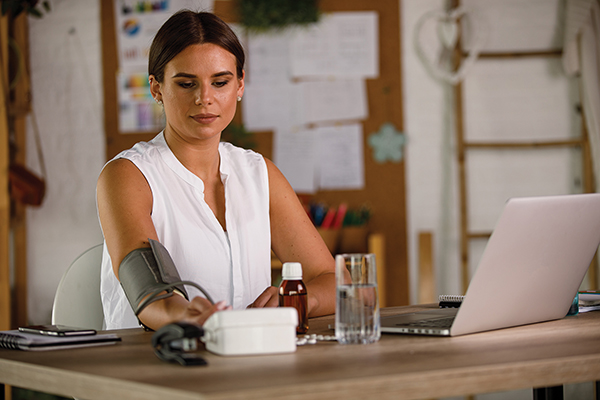
(Family Features) It may not be widely known that women face unique risk factors for stroke throughout their lifetime. Things like pregnancy, preeclampsia, and chronic stress can increase the risk for high blood pressure, a leading cause of stroke.
Cardiovascular disease, including stroke, is the leading cause of death among women, according to the Centers for Disease Control and Prevention (CDC), and 1 in 5 women will have a stroke. However, a large majority of strokes can be prevented.
Caring for yourself by understanding your risk factors can help reduce your risk for stroke and provide a better quality of life. Start managing your stroke risk with these tips from the American Stroke Association, a division of the American Heart Association:
Monitor Your Blood Pressure
 The first step you can take in reducing your risk for stroke is knowing your blood pressure and keeping it in a healthy range. High blood pressure is the No. 1 preventable cause of stroke, according to the American Heart Association.
The first step you can take in reducing your risk for stroke is knowing your blood pressure and keeping it in a healthy range. High blood pressure is the No. 1 preventable cause of stroke, according to the American Heart Association.
The best way to know your blood pressure is to have it measured at least once per year by a healthcare professional and regularly monitor it at home then discuss the numbers with a doctor. For most people, normal blood pressure should be 120/80 mm HG or less.
In addition to properly monitoring blood pressure, maintaining a healthy weight, being physically active, eating healthfully, and reducing or eliminating alcohol and tobacco usage can help control blood pressure. If you do develop high blood pressure, work with a healthcare professional on a plan to help manage it.
Plan for Pregnancy
In the United States, high blood pressure during pregnancy is becoming more common, according to the CDC, and medical conditions including preeclampsia, gestational diabetes, and blood clots during pregnancy all increase stroke risk during and immediately following a pregnancy.
Managing conditions like high blood pressure before getting pregnant helps keep you and your baby healthy during pregnancy and beyond. In addition, your health during and immediately after pregnancy can shape the lifelong health of you and your child. If you’re planning to become pregnant or are currently pregnant, it’s important to regularly monitor your blood pressure.
Take Care of Your Mental Health
Some stress is unavoidable but constant stress is not healthy. Chronic or constant stress may lead to high blood pressure and other unhealthy behavior choices, which can increase the risk for stroke.
Based on findings in a Stress in America 2020 survey conducted by the American Psychological Association, the top sources of stress are money, work, family responsibilities, and health concerns. Managing your stress and blood pressure can improve your overall health and well-being. Reclaim control of your schedule and build in time to invest in your health. Find 10 minutes every day to do something for you, like listening to music, meditating, or going for a walk.
Learn the Warning Signs
A stroke can happen to anyone at any point in life. Immediate treatment may help minimize the long-term effects of a stroke and even prevent death. Learn how to spot a stroke F.A.S.T:
- Face drooping – Does one side of the face droop or is it numb? Ask the person to smile. Is the person’s smile uneven?
- Arm weakness – Is one arm weak or numb? Ask the person to raise both arms. Does one arm drift downward?
- Speech difficulty – Is speech slurred? Is the person unable to speak or hard to understand? Ask the person to repeat a simple sentence like “The sky is blue.”
- Time to call 911 – If someone shows any of these symptoms, even if the symptoms go away, call 911 and get to a hospital immediately. Check the time so you’ll know when the first symptoms appeared.
Talk to your doctor about ways to improve your well-being and help prevent stroke. Find more wellness tips at stroke.org.
Photos courtesy of Getty Images
American Stroke Association
